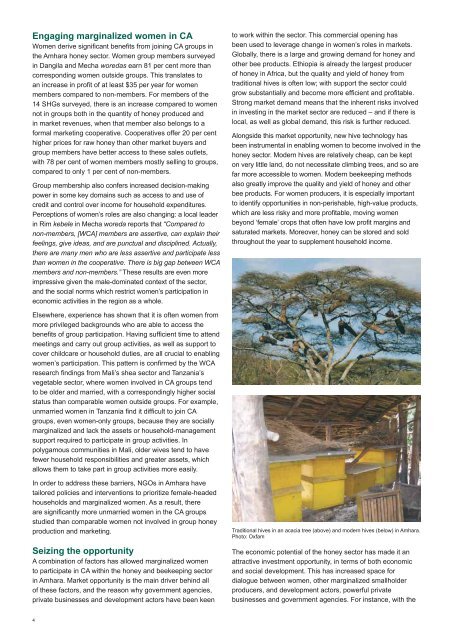Women's Collective Action in the Honey Sector in ... - Oxfam Blogs
Women's Collective Action in the Honey Sector in ... - Oxfam Blogs
Women's Collective Action in the Honey Sector in ... - Oxfam Blogs
Create successful ePaper yourself
Turn your PDF publications into a flip-book with our unique Google optimized e-Paper software.
Engag<strong>in</strong>g marg<strong>in</strong>alized women <strong>in</strong> CA<br />
Women derive significant benefits from jo<strong>in</strong><strong>in</strong>g CA groups <strong>in</strong><br />
<strong>the</strong> Amhara honey sector. Women group members surveyed<br />
<strong>in</strong> Dangila and Mecha woredas earn 81 per cent more than<br />
correspond<strong>in</strong>g women outside groups. This translates to<br />
an <strong>in</strong>crease <strong>in</strong> profit of at least $35 per year for women<br />
members compared to non-members. For members of <strong>the</strong><br />
14 SHGs surveyed, <strong>the</strong>re is an <strong>in</strong>crease compared to women<br />
not <strong>in</strong> groups both <strong>in</strong> <strong>the</strong> quantity of honey produced and<br />
<strong>in</strong> market revenues, when that member also belongs to a<br />
formal market<strong>in</strong>g cooperative. Cooperatives offer 20 per cent<br />
higher prices for raw honey than o<strong>the</strong>r market buyers and<br />
group members have better access to <strong>the</strong>se sales outlets,<br />
with 78 per cent of women members mostly sell<strong>in</strong>g to groups,<br />
compared to only 1 per cent of non-members.<br />
Group membership also confers <strong>in</strong>creased decision-mak<strong>in</strong>g<br />
power <strong>in</strong> some key doma<strong>in</strong>s such as access to and use of<br />
credit and control over <strong>in</strong>come for household expenditures.<br />
Perceptions of women’s roles are also chang<strong>in</strong>g: a local leader<br />
<strong>in</strong> Rim kebele <strong>in</strong> Mecha woreda reports that “Compared to<br />
non-members, [WCA] members are assertive, can expla<strong>in</strong> <strong>the</strong>ir<br />
feel<strong>in</strong>gs, give ideas, and are punctual and discipl<strong>in</strong>ed. Actually,<br />
<strong>the</strong>re are many men who are less assertive and participate less<br />
than women <strong>in</strong> <strong>the</strong> cooperative. There is big gap between WCA<br />
members and non-members.” These results are even more<br />
impressive given <strong>the</strong> male-dom<strong>in</strong>ated context of <strong>the</strong> sector,<br />
and <strong>the</strong> social norms which restrict women’s participation <strong>in</strong><br />
economic activities <strong>in</strong> <strong>the</strong> region as a whole.<br />
to work with<strong>in</strong> <strong>the</strong> sector. This commercial open<strong>in</strong>g has<br />
been used to leverage change <strong>in</strong> women’s roles <strong>in</strong> markets.<br />
Globally, <strong>the</strong>re is a large and grow<strong>in</strong>g demand for honey and<br />
o<strong>the</strong>r bee products. Ethiopia is already <strong>the</strong> largest producer<br />
of honey <strong>in</strong> Africa, but <strong>the</strong> quality and yield of honey from<br />
traditional hives is often low; with support <strong>the</strong> sector could<br />
grow substantially and become more efficient and profitable.<br />
Strong market demand means that <strong>the</strong> <strong>in</strong>herent risks <strong>in</strong>volved<br />
<strong>in</strong> <strong>in</strong>vest<strong>in</strong>g <strong>in</strong> <strong>the</strong> market sector are reduced – and if <strong>the</strong>re is<br />
local, as well as global demand, this risk is fur<strong>the</strong>r reduced.<br />
Alongside this market opportunity, new hive technology has<br />
been <strong>in</strong>strumental <strong>in</strong> enabl<strong>in</strong>g women to become <strong>in</strong>volved <strong>in</strong> <strong>the</strong><br />
honey sector. Modern hives are relatively cheap, can be kept<br />
on very little land, do not necessitate climb<strong>in</strong>g trees, and so are<br />
far more accessible to women. Modern beekeep<strong>in</strong>g methods<br />
also greatly improve <strong>the</strong> quality and yield of honey and o<strong>the</strong>r<br />
bee products. For women producers, it is especially important<br />
to identify opportunities <strong>in</strong> non-perishable, high-value products,<br />
which are less risky and more profitable, mov<strong>in</strong>g women<br />
beyond ‘female’ crops that often have low profit marg<strong>in</strong>s and<br />
saturated markets. Moreover, honey can be stored and sold<br />
throughout <strong>the</strong> year to supplement household <strong>in</strong>come.<br />
Elsewhere, experience has shown that it is often women from<br />
more privileged backgrounds who are able to access <strong>the</strong><br />
benefits of group participation. Hav<strong>in</strong>g sufficient time to attend<br />
meet<strong>in</strong>gs and carry out group activities, as well as support to<br />
cover childcare or household duties, are all crucial to enabl<strong>in</strong>g<br />
women’s participation. This pattern is confirmed by <strong>the</strong> WCA<br />
research f<strong>in</strong>d<strong>in</strong>gs from Mali’s shea sector and Tanzania’s<br />
vegetable sector, where women <strong>in</strong>volved <strong>in</strong> CA groups tend<br />
to be older and married, with a correspond<strong>in</strong>gly higher social<br />
status than comparable women outside groups. For example,<br />
unmarried women <strong>in</strong> Tanzania f<strong>in</strong>d it difficult to jo<strong>in</strong> CA<br />
groups, even women-only groups, because <strong>the</strong>y are socially<br />
marg<strong>in</strong>alized and lack <strong>the</strong> assets or household-management<br />
support required to participate <strong>in</strong> group activities. In<br />
polygamous communities <strong>in</strong> Mali, older wives tend to have<br />
fewer household responsibilities and greater assets, which<br />
allows <strong>the</strong>m to take part <strong>in</strong> group activities more easily.<br />
In order to address <strong>the</strong>se barriers, NGOs <strong>in</strong> Amhara have<br />
tailored policies and <strong>in</strong>terventions to prioritize female-headed<br />
households and marg<strong>in</strong>alized women. As a result, <strong>the</strong>re<br />
are significantly more unmarried women <strong>in</strong> <strong>the</strong> CA groups<br />
studied than comparable women not <strong>in</strong>volved <strong>in</strong> group honey<br />
production and market<strong>in</strong>g.<br />
Seiz<strong>in</strong>g <strong>the</strong> opportunity<br />
A comb<strong>in</strong>ation of factors has allowed marg<strong>in</strong>alized women<br />
to participate <strong>in</strong> CA with<strong>in</strong> <strong>the</strong> honey and beekeep<strong>in</strong>g sector<br />
<strong>in</strong> Amhara. Market opportunity is <strong>the</strong> ma<strong>in</strong> driver beh<strong>in</strong>d all<br />
of <strong>the</strong>se factors, and <strong>the</strong> reason why government agencies,<br />
private bus<strong>in</strong>esses and development actors have been keen<br />
Traditional hives <strong>in</strong> an acacia tree (above) and modern hives (below) <strong>in</strong> Amhara.<br />
Photo: <strong>Oxfam</strong><br />
The economic potential of <strong>the</strong> honey sector has made it an<br />
attractive <strong>in</strong>vestment opportunity, <strong>in</strong> terms of both economic<br />
and social development. This has <strong>in</strong>creased space for<br />
dialogue between women, o<strong>the</strong>r marg<strong>in</strong>alized smallholder<br />
producers, and development actors, powerful private<br />
bus<strong>in</strong>esses and government agencies. For <strong>in</strong>stance, with <strong>the</strong><br />
4

















